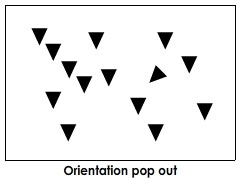Debriefing
Have a look at the typical results from a visual search experiment. First note that in the feature search, where all the distractors were red circles and a green circle was present or absent, the number of items presented does not affect response time. This is because colour is processed preattentively, or automatically, and we are able to group items based on colour without attending to each item individually. This effect is known as the pop-out effect. Colour, luminance, orientation, motion direction and velocity all produce a pop-out effect in visual search experiments, suggesting that these visual features are all processed automatically and without attention.
Here are some examples of pop out, find the ‘different’ stimulus in the array.

The results from the conjunction search condition are much different. The response time for both target present and target absent trials increases as the number of items in the array increases. Feature Integration Theory (FIT) proposed by Treisman and Gelade (1980) explains this finding by suggesting that while individual features (such as colour and shape) are processed in parallel, binding those features into a single object, such as a target that contains features present in other items in the array, requires attention. So in the conjunction search, where it is necessary to bind multiple features of ‘green and circle’ to determine if an item is the target, items need to be attended to one by one until the target is found. When more items are in the array the participant must, on average, pay attention to more items before discovering the target and thus response time increase with the number of items in the array. Response times are longer on target absent trials because participants must look at all items in the array to be certain that there is no target present, whereas on target present trials participants will only search the array until they find the target which will, on average, be after looking at about half of the stimuli in the array.
